Browse Exhibits (12 total)
The Connection Between Americanization efforts and an Immigration Wave
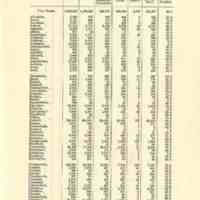
This exhibit focuses on how a wave of immigrants changed the way the United States handled Americanization efforts. Between 1880 and 1920, large numbers of “new” immigrants, those of Catholic and Jewish religions and non-English speakers, came to the United States. These immigrants influenced the Americanization efforts that were enacted in the United States.The exhibit contains artifacts from Josephine Zielinska, a Polish immigrant, documents from the Massachusetts Board of Education, and material from the U.S Census Bureau.
Mary O'Rourke's World Travels

This exibit contains artifacts from Mary O'Rourke, a Salem Stage College professor who received a Fulbright to study the education system in Pakistan. These items help illuminate how Americans viewed Southeast Asian culture.
Pennsylvania German is the new Dutch - Postcards from Salem
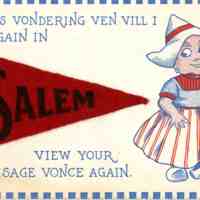
Welcome to the exhibit of 'Dutch' postcards from Salem!
In this exhibit you will learn more about ethnic humor, and the merging of immigrant culture with American culture. Specifically, it adresses some stereotypes of Dutch and German people in the 1910s and how that inspired poetry, literature and other public entertainment.
curated by Sabrina Fritz
Trade Cards: A Marketing Method

Post cards, also referred to as "trade" cards, indirectly advertise cultural products. Not much attention has been given to the fact that the majority of these trade cards were intelligent forms of business methods. Messages could be written on the back of each card so the trade cards could be sent from one place to another. This gets the idea of the object or place advertised a known among numerous groups of people. Today, the common "trading" card is considered a business card. This card can be handed out with ease and have many copies of itself. Yes, postcards are still somewhat relelvant in today's society, however, they are not used in the same manners like how they were in the past. Many post cards are just considered "souvenirs" these days. Postcards are no longer effective ways to advertise; today, we have social media and the television (etc.). Old post cards were printed on earthcolored paper. They had small artistic features. Much effort is shown when we look at the intricate designs. They could be easily held in your hands. This is much like an individualized business card. Post cards from the late 18th to early 19th century hold "aesthetic properties" that make each card visually apealling. Post card designs and photographs were a key factor that made the trading industries between Salem, MA and the U.S., and other countries such as China and India, thrive. Post cards are accurate representations of time periods and often reflect the types of trade. If these cards are further analyzed, it is easy to determine which specific products were being advertised, and which products were in demand. We can view where these post cards came from and see the distance it traveled. Then, we must think, "why here?" What purpose did this postcard serve for the trading between countries? In this exhibit, postcards from the Whitman Collection from the Salem State University Archive's Collection will be further looked at and confirm the statement that these cards were an effective marketing method.
Written by: Stefanie Bennett
World War II Letters
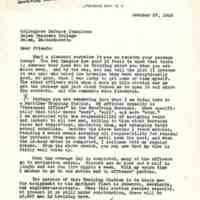
When looking at Salem in the world, not many peoples' first thoughts are about war. Wars displace people and are a huge reason for migration. World War ll is no exception to this. When the United States decided to deploy troops during World War ll, the people of Salem were a part of that. During that time it was more difficult to communicate and luckily for us everything was written down and some of it was preserved. These letters show the impact that these people in Salem had on the world around them, but also the influences that they brought back to Salem after serving in the armed forces.
Miss McGlynn, a woman from Salem, wrote to the men deployed during World War ll from Salem. She wrote to many men and women, but in this exibit we will look at her correspondence with two men.
Franco-Americans & Their Influence in Salem, Mass
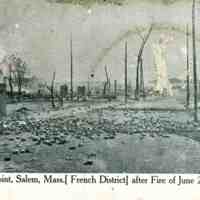
Welcome to the French-Canadian Influence in Salem, Mass. In this exhibit, you will find photos that connect to just how this major immigrant population helped influence Salem between the 1880's and the 1950's.
American Trade with China
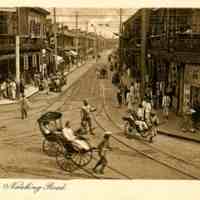
Welcome to the American Trade with China Exhibit!
It was inspired by Walter G. Whitman, a professor at Salem Normal School, who received a Rockefeller Foundation award to teach at Nanking University in Nanking, China from 1925-1926. During his stay there, he collected many local postcards, photographs, and kept a journal of his experiences. The Walter G. Whitman Collection is now housed in the Salem State University Archives and Special Collections.
Gender, Massachusetts Residents, & World War II
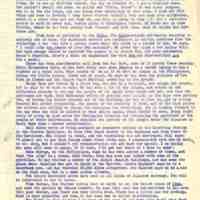
This exhibit explores the different ways in which gender impacted Massachusetts residents experiences of military service during World War II. Artifacts in this exhibit include: World War II letters from Salem Teachers College students and alumni, Salem Newsletters (dated between 1942-1945), and Foreign Currency.
Americanization in 1919 and 1920
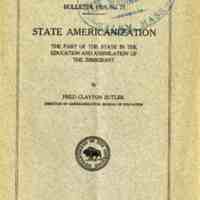
This Exhibit contains artifacts that describe Americanization during 1919 and 1920. All three of these artifacts talk about education, one specifically about Women. These artifacts answer my research question about Americanization.
Chinese Culture v. American Culture in the 1920's
Welcome to the Chinese culture versus the American culture in the 1920's exhibit. In this exhibit, you will find letters written by Walter G. Whitman from 1925 to 1926 talking about his time in China.